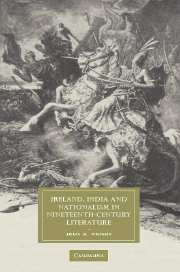Book contents
- Frontmatter
- Contents
- Acknowledgments
- Introduction: Insensible Empire
- PART I National Feeling, Colonial Mimicry, and Sympathetic Resolutions
- PART II Colonial Gothic and the Circulation of Wealth
- Conclusion: The Wild Irish Boy in India
- Notes
- Bibliography
- Index
- CAMBRIDGE STUDIES IN NINETEENTH-CENTURY LITERATURE AND CULTURE
Conclusion: The Wild Irish Boy in India
Published online by Cambridge University Press: 31 July 2009
- Frontmatter
- Contents
- Acknowledgments
- Introduction: Insensible Empire
- PART I National Feeling, Colonial Mimicry, and Sympathetic Resolutions
- PART II Colonial Gothic and the Circulation of Wealth
- Conclusion: The Wild Irish Boy in India
- Notes
- Bibliography
- Index
- CAMBRIDGE STUDIES IN NINETEENTH-CENTURY LITERATURE AND CULTURE
Summary
“There is a white boy by the barracks waiting under a tree who is not a white boy.”
Rudyard Kipling, Kim (1901)In 1901, Rudyard Kipling published one of the more famous and widely discussed imperialist texts of the late Victorian period: Kim. The title character is a child who is devoted to a Tibetan lama and reluctant to attend an English-run school, but is happy to spy for the British Raj. He is, moreover, uniquely fitted to act as a spy in India because he has been raised in India among Indians, rather than in British enclaves, and so can “pass” as Indian. But Kipling's Kim, as I would like to argue here by way of concluding my larger study, is the product not only of the Indian Mutiny of 1857–1858 and the consolidation of British power in Victorian India, but also of the cultural threads that I have been tracing which both align and carefully distinguish between Ireland and India as colonized spaces. Kim is Irish – in many regards a “wild Irish boy” because uneducated and largely unparented – and the specifics of Kipling's representation of Kim seek to detach useful Irish characteristics from the Irish context in order to put them to work in the Indian context.
While postcolonial readings have generally conflated Kim with the British and, more recently, represented him as a figure of whiteness, Kipling specifies Kim's Irishness and on terms that necessarily complicate his alignment with imperial hegemony.
- Type
- Chapter
- Information
- Ireland, India and Nationalism in Nineteenth-Century Literature , pp. 211 - 216Publisher: Cambridge University PressPrint publication year: 2007
- 1
- Cited by



